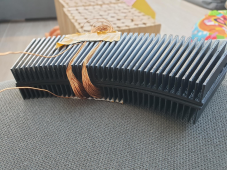the only thing I am worried about when using this winding concept, basically that one winding direction is further away from the flux source than the other, is the iron powder can not saturate all the way through resulting in an unbalanced coil
Saturation, as I am measuring it, occurs if I put a certain amount of current through a coil (and no cancelling current flows through another coil). Above that current, no further magnetization occurs and inductance decreases to air-core. No harm, no foul.
Doing similar by applying voltage, bad things can occur. With DC or too low a frequency, after a brief time current rises until saturation, then inductance drops by a factor of thousands and current shoots up to whatever DC resistance allows.
For a generator, I think saturation would mean you don't get any more current from it, and magnet moves freely without much resistance.
There is something about how core couples flux to [other] coil, and a loss of coupling if insufficient core, so their fields don't cancel each other. Probably leakage flux occurs and can be measured.
Core shape probably affects field strength in one part vs. another, like current distributing according to resistance in conductors, but with different current density due to cross section and shape. The skinny parts might start leaking first.
Imbalance from one portion of the rotor vs. another due to asymmetry could induce mechanical vibrations.
Non-uniform flux density through the coils probably isn't any big issue, just less efficient utilization of materials.
Force one wires causing them to bend/vibrate I think will become an issue at higher power. Probably need to be potted or lacquered into place so mechanical force is transmitted through the potting rather than by torsion on dangling loop ends.






